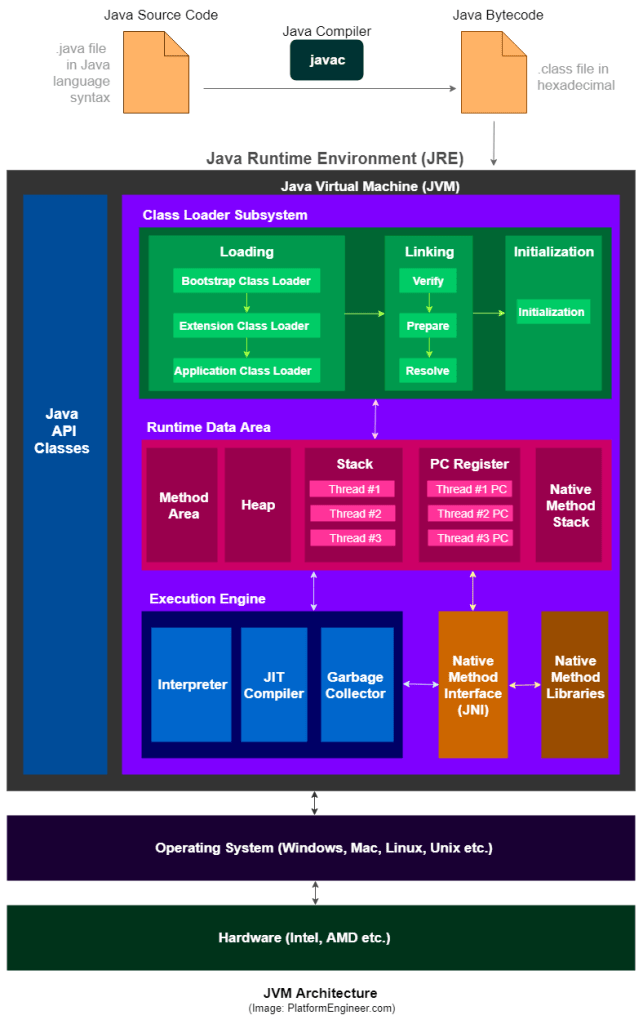线程同步模式:用户态和内核态
线程间的同步方法大体可分为两类:用户模式和内核模式。顾名思义,内核模式 就是指利用系统内核对象的单一性来进行同步,使用时需要切换内核态与用户态, 而用户模式就是不需要切换到内核态,只在用户态完成操作。
- 用户模式下的方法有:原子操作(例如一个单一的全局变量),临界区。
- 内核模式下的方法有:事件,信号量,互斥量
volatile 关键字
volatile 提供多线程共享变量可见性和禁止指令重排序优化:
- 对于可见性,Java 提供了 volatile 关键字来保证可见性。 当一个共享变量被 volatile 修饰时,它会保证修改的值会立即被更新到主存,当 有其他线程需要读取时,它会去内存中读取新值
- 禁止指令重排序优化,写操作一定在读操作之后
值传递
当一个对象被当作参数传递到一个方法后,此方法可改变 这个对象的属性,并可返回变化后的结果
Java诊断利器Arthas
curl -O https://arthas.aliyun.com/arthas-boot.jar
java -jar arthas-boot.jar
[arthas@9208]$ thread 1
"main" Id=1 TIMED_WAITING
at [email protected]/java.lang.Thread.sleep(Native Method)
at [email protected]/java.lang.Thread.sleep(Thread.java:339)
at [email protected]/java.util.concurrent.TimeUnit.sleep(TimeUnit.java:446)
JVM MEMORY MODEL

javax.net.ssl.SSLException: Received fatal alert: protocol_version
On Java 1.8 default TLS protocol is v1.2. On Java 1.6 and 1.7 default is obsoleted TLS1.0. I get this error on Java 1.8, because url use old TLS1.0
echo 'export JAVA_TOOL_OPTIONS="-Dhttps.protocols=TLSv1.2"' >> ~/.bashrc
source ~/.bashrc
访问可见性
| 修饰符 | 类 | 包 | 子类 | 所有人 |
|---|---|---|---|---|
| public | 是 | 是 | 是 | 是 |
| protected | 是 | 是 | 是 | 否 |
| 没有修饰符 | 是 | 是 | 否 | 否 |
| private | 是 | 否 | 否 | 否 |
方法签名
方法签名包括
- 方法名
- 参数类型
- 参数顺序
不包括
- 返回类型
- 可见性
- 抛出例外
过载和覆盖
- 过载: 方法名称相同但签名不同
- 覆盖:
- 签名相同,而且返回类型也必须相同
- 可见性不能减少,可以增加可见性
- 例外必须相同或者是父类例外的子类
visibility and Atomicity
in the absence of synchronization, there are a number of reasons a thread might not immediately ‐ or ever ‐ see the results of an operation in another thread. Compilers may generate instructions in a different order than the “obvious” one suggested by the source code, or store variables in registers instead of in memory; processors may execute instructions in parallel or out of order; caches may vary the order in which writes to variables are committed to main memory; and values stored in processor‐local caches may not be visible to other processors. These factors can prevent a thread from seeing the most up‐to‐date value for a variable and can cause memory actions in other threads to appear to happen out of order ‐ if you don’t use adequate synchronization.
Lock and ReentrantLock
Before Java 5.0, the only mechanisms for coordinating access to shared data were synchronized and volatile. Java 5.0 adds another option: ReentrantLock. Contrary to what some have written, ReentrantLock is not a replacement for intrinsic locking, but rather an alternative with advanced features for when intrinsic locking proves too limited
Intrinsic locking works fine in most situations but has some functional limitations ‐ it is not possible to interrupt a thread waiting to acquire a lock, or to attempt to acquire a lock without being willing to wait for it forever. Intrinsic locks also must be released in the same block of code in which they are acquired; this simplifies coding and interacts nicely with exception handling, but makes non‐blockstructured locking disciplines impossible
ReadWriteLock
The locking strategy implemented by read‐write locks allows multiple simultaneous readers but only a single writer. In practice, read‐write locks can improve performance for frequently accessed read‐mostly data structures on multiprocessor systems; under other conditions they perform slightly worse than exclusive locks due to their greater complexity. Whether they are an improvement in any given situation is best determined via profiling; because ReadWriteLock uses Lock for the read and write portions of the lock, it is relatively easy to swap out a read‐write lock for an exclusive one if profiling determines that a read‐write lock is not a win.
hashtable
- Hashtable is synchronized, whereas HashMap is not. This makes HashMap better for non-threaded applications, as unsynchronized Objects typically perform better than synchronized ones.
- Hashtable does not allow null keys or values. HashMap allows one null key and any number of null values.
- One of HashMap’s subclasses is LinkedHashMap, so in the event that you’d want predictable iteration order (which is insertion order by default), you could easily swap out the HashMap for a LinkedHashMap. This wouldn’t be as easy if you were using Hashtable.
HashTable is obsolete in Java 1.7 and it is recommended to use ConcurrentMap implementation
Java Memory Model
The Java Memory Model is specified in terms of actions, which include reads and writes to variables, locks and unlocks of monitors, and starting and joining with threads. The JMM defines a partial ordering [2] called happens‐before on all actions within the program
soft reference
four different degrees of reference strength: strong, soft, weak, and phantom, in order from strongest to weakest
SoftReferences aren’t required to behave any differently than WeakReferences, but in practice softly reachable objects are generally retained as long as memory is in plentiful supply. This makes them an excellent foundation for a cache, such as the image cache described above
checked exception
The cardinal rule in deciding whether to use a checked or an unchecked exception is this: use checked exceptions for conditions from which the caller can reasonably be expected to recover. By throwing a checked exception, you force the caller to handle the exception in a catch clause or to propagate it outward. Each checked exception that a method is declared to throw is therefore a potent indication to the API user that the associated condition is a possible outcome of invoking the method.